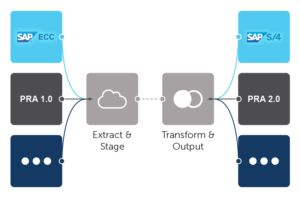When you’re an energy business consultancy with substantial IT and data management competencies, you tend to build your own software to accelerate and improve project delivery. That’s exactly what Stonebridge has done with ORBit, our secret weapon for cutting data management costs in half for SAP-scale implementations, software upgrades, and post-M&A data integration projects.
Let’s look at how ORBit achieved such breakthrough efficiency and how your team can now leverage our data transformation technology for your own projects.
Moving Very Large Transactional Datasets
There are two sides to the data management coin: master data and transactional data. Master data tends to remain stable over time where the challenge arises from choosing among multiple versions of the truth, normalizing, and ensuring data quality. Though complex to manage, master datasets tend to be relatively small compared to transactional data, which is substantially larger due to the volume, variety, and velocity of data (also the 3 V’s that define a “big data” challenge).
Managing even a small number of wells generates a torrent of transactional data, from daily production allocation, custody transfer measurement, and sales runs to AFEs and Jibs, contracts, procurement, and the list goes on. And that’s just field data. Transactional datasets also include logistical data, AR/AP, payroll, energy trading, and midstream transactions. For energy companies on the SAP technology stack, transactional data is spread across many systems, including the core ERP Central Component (ECC), Production Revenue Accounting (PRA), Joint Venture Accounting (JVA), SAP Financials (FI), and Enterprise Portfolio and Project Management (EPPM).
SAP customers on the legacy ECC platform must move to SAP’s next generation platform, S/4HANA, as soon as 2025 or as late as 2027 depending on what support packages customers have opted for. It’s during software upgrades of this scale that moving extremely large volumes of transactional datasets from many complex sources becomes a big data dilemma. But the typical solution from software implementation and upgrade consultants is to throw people at the problem where time and materials related to transactional data migration can account for half of project costs. And transactional data migration projects are just as complex and expensive for implementing an entirely new ERP where data has to be stitched together and shuffled between the old and new systems.
Amidst increasing consolidation, mergers and acquisitions are another area where energy companies face large scale transactional data migration complexity. Combined with the impending SAP S/4HANA upgrade deadline, energy companies need to get really good at moving big data, and fast.
How ORBit Changes the Data Transformation Game
If SAP, Oracle, and Microsoft ERPs represent the digital core of transactional data, its fringe connects to a wide variety of energy-specific software, both on-premise and cloud-based. The edge apps each have their own databases, resulting in dozens or even hundreds of data silos. All of these core and edge databases strand transactional data in systems of record, which is why data migration for M&A and software implementation are so complex and costly. Like oil trapped in low permeability shale rock, this digital black gold must be virtually frac’ed to unlock the flow. Enter ORBit.
Fracing data with ORBit begins with 50+ pre-built connectors to ERP and energy-specific commercial software products, like SAP FI and EPPM as well as PRA, JVA, Peloton, and Quorum products. ORBit’s data connectors can instantly create a digital gathering system for as much as 70% of an energy enterprise’s core and edge app ecosystem. And where needed, rapidly build new connectors via API or direct connect (SQL Server, Oracle, MongoDB, etc.). Such data pipelines are built with scale, reliability, and speed in mind, enabling vast volumes to be gathered and fed into ORBit.
Next, data from different sources can be joined using powerful merge tools that allow data managers to map source transactional records to the destination by building matching business objects with drag and drop ease for no-code data transformations. Or low code with the ability to create custom database queries.

Put ORBit to Work for Your Team
Built on SAP’s Business Technology Platform, ORBit can scale to meet the data transformation needs of any one-off project or fill operational data management gaps that require large volumes of transactional data to be moved on a routine schedule. Stonebridge deploys ORBit alongside our consultants to support M&A integration and software implementation projects for differentiated service that makes us the go-to partner for the energy industry (in fact, we’re managing three of the largest mergers this year).
ORBit is now available directly to the energy industry through a Data-as-a-Service (DaaS) subscription and fixed pricing regardless of the size of data volumes. ORBit is the right tool for the job whether you’re managing an S/4HANA journey internally, onboarding M&A, moving big transactional datasets for AI and machine learning initiatives, or streamlining remediation workflows between IT and business stakeholders vs. the highly manual, endless loop of reconciling numbers in spreadsheets. Gain greater agility and cost-efficiency for your next project with ORBit while completing projects in half the time by automating big data transformations instead of throwing people at the problem.
Contact Stonebridge today for a personalized demonstration of ORBit and experience the power of big data transformation for yourself.

